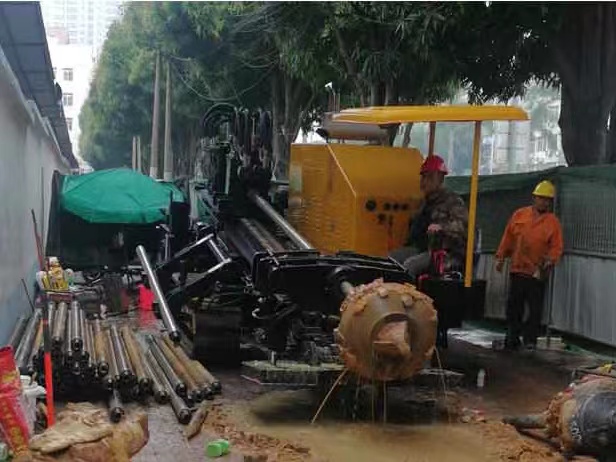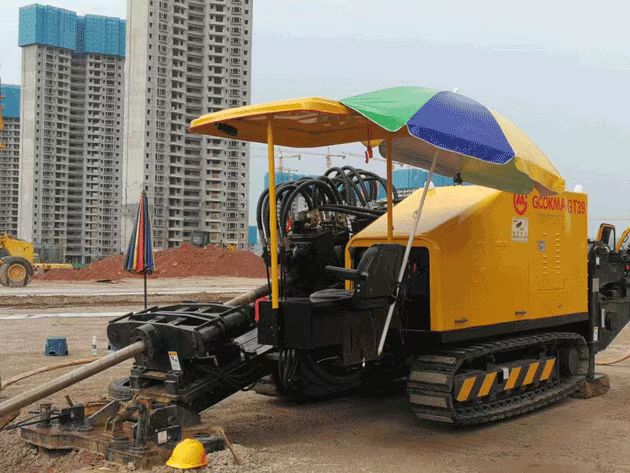1.Pipe pullback
Measures to prevent pullback failure:
(1) Perform visual inspection of all drilling tools before horizontal directional drilling work, and perform flaw detection inspection (Y-ray or X-ray inspection, etc.) on major drilling tools such as drill pipes, reamers, and transfer boxes to ensure that there are no cracks and the strength meets the construction requirements.
(2) The final diameter of the reaming is greater than 1.5 times of the pullback pipe.The connection sequence of pipeline pullback:power head – power head protection nipple – drill pipe – reamer – swivel joint – U-shaped ring – tractor head – main line,which can ensure that most of the power of the drill is applied to the pull force during the pullback process and ensure the success of pullback.When stopping drilling, the drilling tool should be connected quickly, and the stagnation time of the drilling tool in the pilot hole should be shortened as much as possible, and should not exceed 4 hours. In case of stagnation, mud shall be injected into the hole at intervals to maintain the fluidity of mud in the hole.
(3) Before the pipeline is pulled back, the drilling rig, drilling tool, mud supporting system and other equipment shall be comprehensively inspected and maintained (with maintenance and repair records attached) to ensure that the drilling rig and its power system have good performance and operate normally. Flush the drill pipe with mud before pulling back to ensure that there is no foreign matter in the drill pipe; The mud system is smooth and the pressure can meet the requirements of pullback. During the pullback, conduct a test spray to ensure that the water nozzle is unblocked. During the pullback, inject appropriate mud according to the drill parameters, reduce the friction between the drill pipe and the hole wall rock, increase the pipeline lubrication, reduce the friction temperature of the drill pipe, and ensure the success of pullback.
Measures to ensure that the pipeline anti-corrosion coating is not damaged when the hole is expanded and pulled back
(1) When drilling the pilot hole, carry out the construction according to the design requirements to ensure that the pilot hole is smooth and flat, and avoid excessive corners. When dragging back, the diameter of the reamer used is more than 1.5 times larger than the diameter of the crossing pipe to reduce the dragging resistance and reduce the scraping phenomenon between the pipe and the hole wall.
(2) Add a hole washing to clean out more cuttings in the hole and reduce the friction of the pipeline in the hole.
(3) The mud ratio changes with the geological conditions. The mud is treated during the pullback, and a certain amount of lubricant is added to reduce the frictional resistance between the pipeline and the hole wall. The mud viscosity must be adjusted at any time according to the actual situation. According to the geological changes, the mud ratio viscosity and pressure are adjusted at any time, and the mud ratio is used to suspend the pipeline in the mud during the pullback to reduce friction.
(4) After the reaming is completed, first check the back-towing pipeline. After confirming that the anti-corrosion layer is intact and there is no social factor interference, according to the site conditions, the pipeline is suspended by excavating sending ditches and soil piles to protect the anti-corrosion layer of the pipeline. .
(5) When the pipeline is towed back, set up an anti-corrosion layer detection point 30 meters before the pipeline enters the hole (or according to the actual situation on site), and arrange special personnel to clean the surface of the anti-corrosion layer before the detection point, so that it is convenient for the personnel at the detection point to use EDM leak detection checks whether there are scratches or leaks on the anti-corrosion layer, and repairs the damage in time when scratches and leaks are found, so as to avoid entering the hole.
2.The proportioning method, recovery and
treatment measures of mud
Preparation of mud:
The ratio of mud plays a decisive role in the success of crossing. The viscosity of the mud configuration of the project will be based on the design drawings and geological prospecting data, according to the allocation of different mud viscosity for different strata, in the process of drilling guide holes, should ensure good rheological properties, lubrication performance; During reaming, the mud viscosity will be adjusted preferably according to the guiding record to ensure that the mud has a strong cuttings carrying capacity and wall protection. At the same time, in each stage of guiding, reaming and backtowing construction, according to the actual data, add wall reinforcement agent, viscosifier, lubricant, chip cleaning agent and other auxiliary agents, increase the mud viscosity and cementation, enhance the stability of the hole, prevent the hole wall collapse, slurry leakage and other phenomena, to ensure the quality of the project completed smoothly. The mud material is mainly bentonite (environmentally friendly), and the mud configuration depends on the soil conditions faced when drilling. For this project through the main formation, mud preparation of the main index.
Mud recovery and treatment:
In order to effectively control the amount of mud, protect the ecological environment, as far as possible to use environmentally friendly mud, recycling, maximum limit to reduce the generation of waste mud, at the same time to prevent the slurry pollution, timely recycling external environmental treatment, specific measures are as follows:
(1) Guide the environment-friendly mud returning from the ground into the circulating system, and through the circulating trough and sedimentation tank, the drilling cuttings will be precipitated to achieve the primary purification effect. After the initial purification, the mud flows into the mud pool to stand. In order to accelerate the precipitation of particles, a baffle is set in the mud pool to change the flow pattern and destroy the structure in the mud, so as to facilitate the precipitation of drilling cuttings.
(2) Arrange special personnel to inspect the line, strengthen the inspection vision, and if there is a slurry leakage point, organize personnel to build a cofferdam at the place where the slurry is leaking to contain and clear it as soon as possible, so as to prevent the slurry from overflowing and the scope of the slurry from expanding. It is collected and then pulled by tank truck to the mud pit on the construction site.
(3) After the construction is completed, the mud in the mud pit on the construction site is separated from mud and water, and the remaining waste mud is transported outside for environmental protection.
3. Special technical measures
Drilling rig anchoring system:
In the process of directional drilling, due to the irregularity of the underground formation structure, the drilling rig is greatly affected by the reaction force of the drill pipe in the hole during reaming and backhauling. The sudden increase of the tension may cause the instability of the drilling rig and even the accident of the drilling rig tipping over. Therefore, the stability of the anchoring system of the drilling rig is particularly important. According to the experience of this project and previous construction, the anchoring system of the drilling rig has been improved, specifically as follows:
(1) Place the ground anchor in the pit, and the middle line of the ground anchor box coincides with the crossing axis. The top of the ground anchor box is flush with the natural ground, and the excavation specification of the ground anchor box is 6m×2m×2m.
(2) The tubular tail anchor is installed 6 meters behind the ground anchor box, and the ground anchor box and tail anchor are connected by connecting rods. After the tail anchor is connected, the earth is backfilled, and the soil around the anchor is pressed mechanically and artificially. Increase the bearing capacity of soil.
(3) Install a 6-meter-long pole on each side of the ground anchor box to prevent the main body from tilting.
(4) Install a 6×0.8m steel pipe at each end of the pole to increase the stress area everywhere and reduce the pressure.
(5) After the installation, the steel plate should be laid in the anchoring system, and the rig should be parked above the steel plate.
Gookma Technology Industry Company Limited is a hi-tech enterprise and a leading manufacturer of horizontal directional drilling machine in China.
You are welcome to contact Gookma for further inquiry!
Post time: Feb-15-2023


